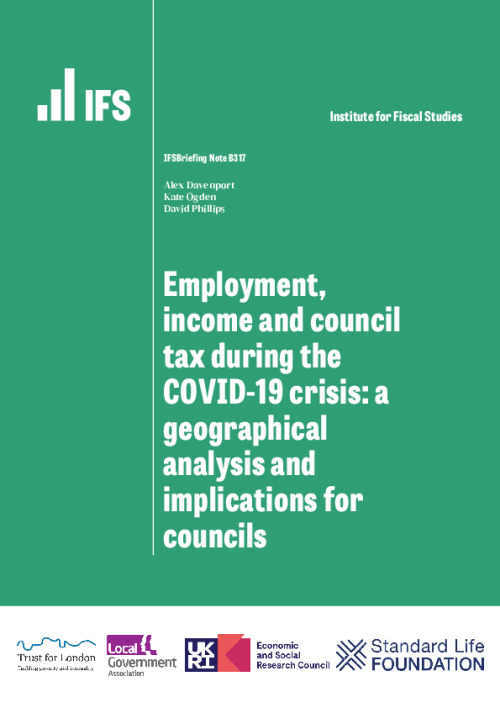The decline in economic activity that has resulted from the COVID-19 crisis and associated public health restrictions have had a significant effect on the finances of households. Employment has fallen, the number of people in receipt of unemployment and means-tested benefits has risen, and a significant number of people have stopped paying large and important bills such as mortgages and council tax, whether on an agreed basis (such as via a mortgage holiday or council tax deferrals) or otherwise. Falls in council tax revenues have, alongside falls in other income streams and increases in spending, contributed to a ‘perfect storm’ for local authorities’ (LAs’) finances as well.
In this briefing note, we update and extend previous IFS analysis, to consider how employment, incomes, benefit claims and council tax payments have evolved over a longer period and have varied geographically, and draw out key implications for local government. This includes a particular look at the characteristics of households that have stopped paying council tax during the COVID-19 crisis – including how their characteristics differ from those of households that stopped paying council tax prior to the COVID-19 crisis, and how their income and spending changes compare with those of households that have continued paying council tax. To do this, we use anonymised data from the Money Dashboard budgeting app, in conjunction with the latest administrative and survey data from households, businesses and local government.
Key findings
- The number of employees on payroll was 3.0% lower by November 2020 than it had been in February 2020, with around three-quarters of this decline taking place during the first national lockdown. Almost 9 million jobs were furloughed during April and May, and around 2.5 million were still furloughed in October. After an initial fall in April and May, the median pay of employees on payroll – including those furloughed – was 3.4% higher by November. However, perhaps half of this growth reflects the fact that lower-paid workers were more likely to lose their jobs, pushing up the average pay of those still in work. And overall household earnings – a measure that also accounts for this fall in employment, as well as the earnings of the self-employed – do not appear to have regained pre-COVID levels by early autumn. In particular, data from the UK Household Longitudinal Survey suggest median household earnings were 3.3% lower in September 2020 than in January/February 2020, although this compares with an 11.5% difference in April.
- England’s second national lockdown, in November, was associated with a more muted impact on the labour market than the first lockdown. In particular, employment, earnings and claims for unemployment-related benefits were similar to earlier in the autumn. The share of workers furloughed did increase from 7% to around 13%, but this compares with around 30% during the first lockdown. This may reflect the shorter and less stringent nature of the second lockdown though, and the current third lockdown may have a larger effect.
- The more muted effect of England’s second lockdown extended to claims for local council tax support (LCTS), which according to figures from LAs, have been broadly steady since July. However, working-age claimant numbers were around 11% (250,000) higher in July–September 2020 than they were in October–December 2019, prior to the COVID-19 crisis. These increases in LCTS costs are one factor behind a shortfall in council tax revenues. While council tax revenues increased 0.4% in the first half of the 2020–21 fiscal year compared with 2019–20, pre-COVID forecasts were for an increase of 5.4%. This suggests a shortfall in revenue of almost £0.9 billion in the first half of the fiscal year, with LAs predicting a full-year impact of around £1.3 billion.
- All regions of the UK have seen substantial falls in the number of employees in paid work, ranging from 1.4% in Northern Ireland, between 2 and 3% in most regions of England, to 5.5% in London. Moreover, even prior to the second lockdown, approximately 6–7% of employees were furloughed in most parts of England, including around 7.5% in the North West and 10% in London. Data from Money Dashboard also suggest that overall household incomes have fallen in all regions, with the largest falls in the South and Midlands of England.
- Council tax shortfalls have been most notable in London, the North East and North West, where in the first half of the 2020–21 fiscal year receipts actually fell year-on-year by 1.4%, 1.3% and 0.2% respectively, despite increases in tax rates of almost 4%.
- This weaker performance partly reflects a larger impact from increases in LCTS claims, but may also reflect increases in payment failures and the pausing of enforcement action. However, it is worth noting that while other regions saw an increase in council tax receipts – of up to 1.7% in the South West of England – all have seen a shortfall relative to pre-COVID forecasts. And the fact that LAs in the South of England rely more on council tax for their funding means overall financial impacts are more evenly distributed across regions.
- Both the numbers claiming unemployment-related benefits and the numbers claiming LCTS have increased most relative to existing claimant numbers in less deprived English LAs. However, they have increased more relative to population in more deprived English LAs, with claims for unemployment-related benefits increasing by the equivalent of 3.7% of the working-age population in the most deprived fifth, compared with 2.4% in the least deprived fifth. This suggests the number of people affected by financial hardship has increased most in the areas where it was already highest.
- Council tax revenues fell by 1.2% in the most deprived fifth of English LAs in the first half of 2020–21, but grew by 2.4% in the least deprived fifth. LAs’ own forecasts for the full year suggest a similar pattern, with the most deprived fifth seeing a shortfall relative to pre-COVID forecasts of 5.4% compared with 2.9% for the least deprived fifth. However, as the least deprived fifth rely on council tax for around 1.6 times the share of their overall core funding that the most deprived fifth do, impacts on overall funding levels are broadly comparable.
- Amongst Money Dashboard users who regularly paid council tax before the crisis, 14.7% did not make a monthly council tax payment in at least one month between April and June 2020. The equivalent figure in 2019 was 12.3%. The proportion missing at least one payment increased between 2019 and 2020 across age groups and most regions, although many households that did not make a payment for the first time in April or May did restart making payments from June. This fits with reports from councils that they allowed around 4% of council tax payers to defer payments to later in the year, but may also reflect payment failure.
- Average (pre- and post-crisis) incomes were lower amongst Money Dashboard users who did not make at least one council tax payment. However, these users were no more likely to have suffered substantial falls in their incomes than those who did not miss any, and they were also no more likely to have stopped paying other bills or to have reduced their spending on other things. However, other data suggest that those who failed to make a payment – rather than getting a deferral, for example – did see larger falls in their income, and suggests a correlation between payment failure, use of deferrals and LCTS claims with more general financial difficulties.
Overall, it is clear that the COVID-19 crisis has had a substantial impact on households’ employment and incomes – albeit significantly mitigated by policies such as the furlough scheme – and, as a result, on their payments of council tax. While the summer and autumn of 2020 showed a slowdown in falls in employment, a levelling-off of benefit claims and some recovery in earnings, the situation over the coming financial year is likely to deteriorate again as the furlough scheme is wound down and unemployment rises. The Office for Budget Responsibility (OBR), for example, forecast in November that unemployment would rise to 7.5% by June, albeit with significant uncertainty: its more optimistic scenario was for unemployment to remain broadly constant at 5.1%, but its more pessimistic scenario was for it to more-than-double to 11% by the start of 2022.
This briefing note also shows how impacts have varied around the country, with London, other urban, and more deprived areas hit harder in terms of employment, reliance on the furlough scheme, benefit claims and council tax revenues (although more affluent areas are more reliant on these revenues). Trends are likely to continue to differ, but how much and in what way will depend on the future shape of the economy, including the extent to which changes in shopping and commuting patterns persist. Evidence on this may begin to emerge during the course of this year, as the COVID vaccination programme hopefully allows a relaxation of most public health restrictions.
The government’s response across a range of policy areas – including benefits, employment and skills, and investment and regional funding – will also matter for outcomes. This includes its approach to local government funding. The way it has addressed shortfalls in council tax revenue that have arisen this year – a grant to cover 75% of the shortfall between collections and pre-COVID forecasts – will not only help ameliorate overall impacts, but will also help minimise the inequalities in funding between LAs that could be driven by differences in the size of shortfalls. The up-front grant funding planned for 2021–22 will be of particular benefit to the most deprived LAs, given it will be based on existing levels of LCTS claims, which are much higher than in more affluent LAs. Plans for 2022–23 and beyond have not been set out though. If extra funding to cover higher LCTS claims is discontinued at that point, as well as impacting on funding for local government as a whole, those LAs seeing the largest increases in the numbers facing unemployment and low incomes may also be particularly affected by shortfalls in revenue.












